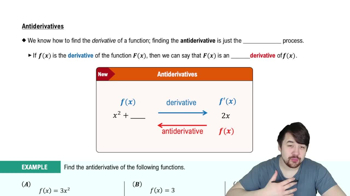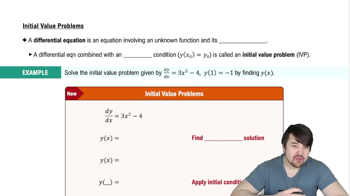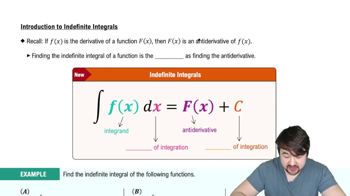Reproduce the graph of f and then plot a graph of f' on the same axes. <IMAGE>
Table of contents
- 0. Functions7h 54m
- Introduction to Functions16m
- Piecewise Functions10m
- Properties of Functions9m
- Common Functions1h 8m
- Transformations5m
- Combining Functions27m
- Exponent rules32m
- Exponential Functions28m
- Logarithmic Functions24m
- Properties of Logarithms36m
- Exponential & Logarithmic Equations35m
- Introduction to Trigonometric Functions38m
- Graphs of Trigonometric Functions44m
- Trigonometric Identities47m
- Inverse Trigonometric Functions48m
- 1. Limits and Continuity2h 2m
- 2. Intro to Derivatives1h 33m
- 3. Techniques of Differentiation3h 18m
- 4. Applications of Derivatives2h 38m
- 5. Graphical Applications of Derivatives6h 2m
- 6. Derivatives of Inverse, Exponential, & Logarithmic Functions2h 37m
- 7. Antiderivatives & Indefinite Integrals1h 26m
- 8. Definite Integrals4h 44m
- 9. Graphical Applications of Integrals2h 27m
- 10. Physics Applications of Integrals 3h 16m
- 11. Integrals of Inverse, Exponential, & Logarithmic Functions2h 31m
- 12. Techniques of Integration7h 41m
- 13. Intro to Differential Equations2h 55m
- 14. Sequences & Series5h 36m
- 15. Power Series2h 19m
- 16. Parametric Equations & Polar Coordinates7h 58m
2. Intro to Derivatives
Basic Graphing of the Derivative
Problem 3.3.32b
Textbook Question
Recovering a function from its derivative
b. Repeat part (a), assuming that the graph starts at (−2, 0) instead of (−2, 3).
 Verified step by step guidance
Verified step by step guidance1
Step 1: Understand the problem. We need to find the original function given its derivative and a starting point on the graph. The starting point is (-2, 0).
Step 2: Recall that the process of recovering a function from its derivative involves integration. If the derivative of a function is given as f'(x), then the original function f(x) can be found by integrating f'(x).
Step 3: Set up the integral of the derivative function. If f'(x) is the derivative, then the integral ∫f'(x) dx will give us f(x) + C, where C is the constant of integration.
Step 4: Use the given point (-2, 0) to find the constant of integration C. Substitute x = -2 into the integrated function f(x) + C and set it equal to 0, since f(-2) = 0.
Step 5: Solve for C using the equation from Step 4. Once C is determined, write the final expression for the original function f(x) by substituting C back into the integrated function.
 Verified video answer for a similar problem:
Verified video answer for a similar problem:This video solution was recommended by our tutors as helpful for the problem above
Video duration:
4mPlay a video:
Was this helpful?
Key Concepts
Here are the essential concepts you must grasp in order to answer the question correctly.
Antiderivative
An antiderivative of a function is another function whose derivative is the original function. To recover a function from its derivative, you find the antiderivative, which involves reversing the differentiation process. This is crucial for understanding how to reconstruct the original function from its rate of change.
Recommended video:

Antiderivatives
Initial Condition
An initial condition specifies the value of the function at a particular point, which is essential for determining the constant of integration when finding an antiderivative. In this problem, the initial condition is given by the point (−2, 0), which helps to uniquely define the recovered function.
Recommended video:

Initial Value Problems
Constant of Integration
The constant of integration arises when computing the antiderivative of a function, representing an infinite family of solutions. It is determined using initial conditions, such as the starting point of the graph, to ensure the recovered function accurately reflects the original function's behavior.
Recommended video:

Introduction to Indefinite Integrals

 6:15m
6:15mWatch next
Master Graphing The Derivative with a bite sized video explanation from Patrick
Start learningRelated Videos
Related Practice
Textbook Question
